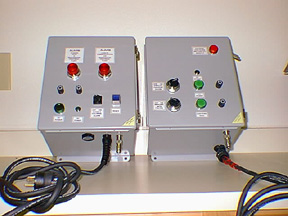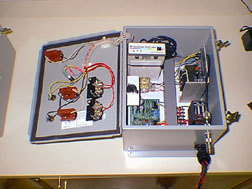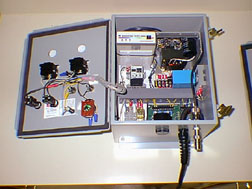Recent Project
Design, Construction and Implementation of a Spread Spectrum
Radio Linked Backup Chlorine Leak Alarm System
For the City of Arcata, California
I was asked by the director of environmental services to find an alternative method of signalling the Arcata police dispatcher if a chlorine leak occurs at the Arcata wastewater treatment plant.
At the treatment plant we process the city's wastewater through a series of oxidation ponds, treatment marshes and wetlands. The final step in this process is to disinfect the water with chlorine gas and neutralize any residual chlorine with sulphur dioxide gas. This necessitates the storage of hazardous gases at the plant. Using widely accepted methods backed with professional certification and a high degree of training of the plant's operators, the usage of these gases is made routine.
To ensure public safety, a network of sensors watches for presence of leaking gas in the vicinity of the storage tanks. Currently any alarms are communicated to the control building alarm display and then to a programmable autodialler which uses the telephone network to notify the city police dispatcher.
 To back up this sequence of devices it was decided to also convey the alarm via a parallel, signalling system. I was asked to come up with an economical solution. After much research I obtained the necessary hardware. The system works thusly:
To back up this sequence of devices it was decided to also convey the alarm via a parallel, signalling system. I was asked to come up with an economical solution. After much research I obtained the necessary hardware. The system works thusly:
At the chlorine building an alarm signal is converted to RS-232 data. This data is fed to a spread spectrum transceiver. A fifty foot radio tower which I researched and requisitioned, holds a small yagi antenna aimed at city hall. At CH, another yagi is connected to a spread spectrum transceiver connected to an RS-232 to relay logic converter board and to peripheral circuitry.
I designed the system so that operators at both ends could be assured as to its functionality and status at a glance.

At the transmit end, indicators show status of 12VDC and 110VAC power (with fuses), and whether the transmitter is periodically testing the communications path.
There are manual switches to simulate a chlorine alarm and to simulate a communications path failure. Inside the cabinet is a switch to defeat the chlorine alarm function at the operator's discretion. There is also an external indicator to remind them when the alarm is deactivated. The frequency of communications path checking pulses is also operator adjustable.

At the receive end there is an external indicator light for chlorine leak
and for communications path failure. The tolerance for required frequency of path checks is also adjustable. Chlorine leak signals trigger an audible alarm. There is a system reset switch, audible alarm override, AC and DC power indicators, and fuse holders.
This was an enjoyable project. I hope it adds to the security of Arcata's citizens.
BACK
site construction/maintenance/imagery by DW
Revised 1-8-98


